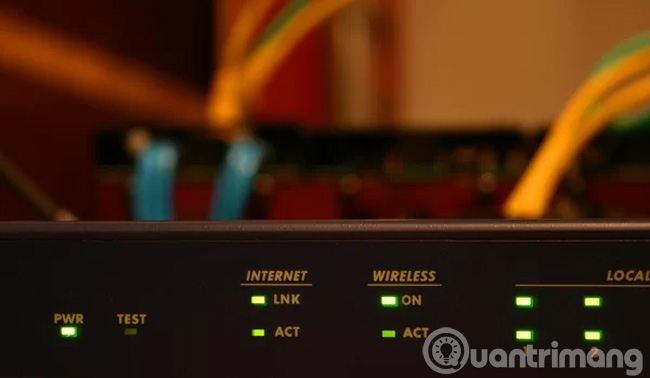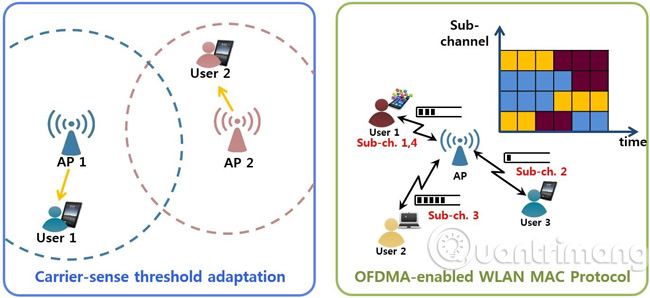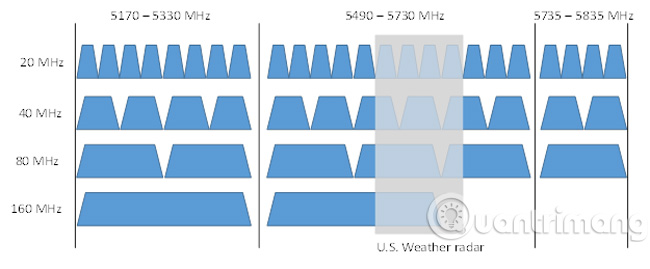Why do you need to learn about IEEE 802.11ax?
- 7 extremely interesting Wifi features on Windows 10 not everyone knows
- What's the newly announced WPA3 wireless security protocol?
- How to use WiFi device from SIM 4G
Of course, any Wi-Fi user appreciates a fast network connection. Please join TipsMake.com to find out the draft IEEE 802.11ax standard for scope, throughput and stability in this article!

The Institute of Electrical and Electronics Engineers (IEEE) develops 802.11 specifications to indicate wireless networking properties. Like any technology, the 802.11 standard is constantly changing.
For example, many current Wi-Fi router routers support 802.11ac, manufactured in 2013. The ac standard, called Gigabit Wi-Fi, has the following properties:
- Maximum speed of 1.3 Gbps;
- Operating in 5-GHz band;
- Connect up to 4 devices at the same time through Multi User - Multi Input Multi Output (MU-MIMO).
What is 802.11ax?

IEEE is striving to complete the 802.11ax standard and plans to publish publicly in 2019. You can refer to the specifications on the IEEE website (http://www.ieee802.org/11). /Reports/tgax_update.htm). In addition, National Instruments has produced an excellent report on 802.11ax that helps readers better understand it.
Perhaps your question at this point is "Why should I care about 802.11.ax? ' To answer that question, let us consider the main benefits that 802.11ax brings to users .
MIMO-OFDM
As mentioned above, MIMO allows a wireless access point to work maximum with 4 separate data streams. 802.11ax has the ability to multiplexed MIMO with the technique of Accessing Orthogonal Frequency Division Access (OFDA) into the table. In general, that means that 802.11ax router routers can transmit 4 MIMO space streams (using multiple antennas to transmit and receive wireless connection signals), maximizing theoretical bandwidth. up 4 times.
(Spatial stream) is often referred to in wireless networks / communications using MIMO.When the wireless signal is transmitted or received simultaneously in a MIMO environment, the signal is transmitted by other antennas. each other is multiplexed by using different spaces in the same spectral channel, these spaces are called spatial streams.)
Speed

Suppose a single 802.11ax stream is 3.5 Gbps, multiplied by 4 times and you will receive a maximum theoretical bandwidth of 14 Gbps. It's fast, but there are always mitigating factors, such as channel width in the 5-GHz band that wireless access points use.
You may ask: 'Why do any of us need such a network speed?'. Yes, please see the idea of taking any of the following actions with a latency of almost zero :
- Watch online 4K resolution video (Ultra HD);
- Download the full details of the game to your dashboard;
- Indoor 'smart' devices have no latency.
The good news is that high-end WiFi devices equipped with 802.11ax are backward compatible with current standards and the older 802.11a / b / g / n / ac standard (in some cases).
Signal reception
Wi-Fi standards have switched to 5-GHz band to reduce conflict with 2.4 GHz household appliances. 802.11ax operates in the 5GHz band. However, the special IEEE 802.11ax design has high stability. In fact, the unofficial name of 802.11ax is "High-Efficiency Wireless" or HEW.
IEEE will design 802.11ax that provides stable, flexible performance even in dense Wi-Fi areas. For example, think about how many wireless Wi-Fi networks (WLANs) compete in both the 2.4-GHz and 5-GHz bands in an apartment building.

Range
In this article, we reveal a little about the range of efficient indoor and outdoor operations supported by 802.11ax. The 802.11n standard, the current Wi-Fi standard, operates with an indoor distance of about 70 meters and an outdoor distance of 240 meters.
The bottom line
If it is difficult to produce and select IEEE 802.11ax, it will be (a) certificate and (b) support the original equipment manufacturer (OEM). Intel and Qualcomm have just announced that chips will be available this year for the new standard. Asus and D-Link both announced their routers will use this standard. However, it takes a while before the new standard becomes an official standard.
The Wi-Fi Alliance will validate Wi-Fi interfaces and devices to see which IEEE 802.11 standards they meet. Although IEEE plans to release 802.11ax specifications in 2019, there is no way to determine how long this certification process will take.
Wi-Fi certification is necessary; Customers can rely on Wi-Fi Alliance certification to buy Wi-Fi equipment. In addition, you also need to know in advance the specifications of the device to be purchased, to make sure it will work in your current network environment.
Refer to some more articles:
- Instructions on how to turn smartphones into monitors for computers via Wifi connection
- Intel is about to launch a new Wifi chip that makes web browsing speed unbelievably fast
- 6 common Wi-Fi network errors and remedies
Having fun!
You should read it
- Intel is about to launch a new Wifi chip that makes web browsing speed unbelievably fast
- 5 things to know before buying a tested 11ax router
- WiFi will reach 1Gbps speed in 2012
- IEEE launched the new generation FireWire standard
- What is Wifi? How does Wifi work?
- What is IEEE 802? What role does it play in shaping modern internet connection?
- WiMax - P.1: WiMax overview
- Fix error Windows 10 PC does not detect 5GHz WiFi network
May be interested
- The secret to effective language learning from a 35-year-old man who speaks 11 languages
 luca lampariello - 35 years old can speak 11 languages including english, japanese, chinese, polish, german, portuguese, french, spanish, dutch, swedish and russian.
luca lampariello - 35 years old can speak 11 languages including english, japanese, chinese, polish, german, portuguese, french, spanish, dutch, swedish and russian. - WiMax - P.1: WiMax overview
 in 2001, ieee released the 802.16 standard for bandwidth wifi access. soon wimax forum was established to develop this standard, and the term wimax was formed.
in 2001, ieee released the 802.16 standard for bandwidth wifi access. soon wimax forum was established to develop this standard, and the term wimax was formed. - How to Set up a Wireless Network in Linux
 a walkthrough of wireless (ieee 802.11 also known as wifi) home networking with linux. most wireless adapters are not designed for use in linux and depend on non-free proprietary drivers and firmware which inevitably leads to problems....
a walkthrough of wireless (ieee 802.11 also known as wifi) home networking with linux. most wireless adapters are not designed for use in linux and depend on non-free proprietary drivers and firmware which inevitably leads to problems.... - WiMax gigabit speed creates 4th generation mobile network
 international electrical and electronic engineering organization ieee has begun to build a 1 gb / second wireless broadband standard version capable of competing for the '4g' title of other technologies and promising. replace both mobile networks and technology itself
international electrical and electronic engineering organization ieee has begun to build a 1 gb / second wireless broadband standard version capable of competing for the '4g' title of other technologies and promising. replace both mobile networks and technology itself - How to Set up a Wireless Network in Windows XP
 this is a walkthrough of setting up wireless (ieee 802.11 also known as wifi) home networking with windows xp. note that if buying a router, all routers are compatible with windows xp. it is wireless adapters that have varying levels of...
this is a walkthrough of setting up wireless (ieee 802.11 also known as wifi) home networking with windows xp. note that if buying a router, all routers are compatible with windows xp. it is wireless adapters that have varying levels of... - Solve the problem with rogue ISP
 the ieee 802.3 standard is introduced to ensure consistency of operation between ethernet devices. but it is awful that each place has a way of understanding, how to translate this standard in a different way. the problem of unifying devices between ethernet networks becomes difficult. often there are many conflicts that require network administrators to meet again
the ieee 802.3 standard is introduced to ensure consistency of operation between ethernet devices. but it is awful that each place has a way of understanding, how to translate this standard in a different way. the problem of unifying devices between ethernet networks becomes difficult. often there are many conflicts that require network administrators to meet again - How to learn English for free with Vndoc, from basic to advanced
 vndoc's prestigious document sharing site has just launched a formal english learning program, from basic to advanced, for beginners, children or people who have lost english roots as well as those who want to improve further. knowledge of your english.
vndoc's prestigious document sharing site has just launched a formal english learning program, from basic to advanced, for beginners, children or people who have lost english roots as well as those who want to improve further. knowledge of your english. - FireWire is officially dead: End of 25 years of existence on macOS
 you probably haven't used a firewire port in years, but the connection standard is still quietly supported in macos.
you probably haven't used a firewire port in years, but the connection standard is still quietly supported in macos. - What is Wifi? How does Wifi work?
 wifi - wireless network, has now played a very important role in our daily life, work and entertainment. but to fully understand the meaning of wifi, what do we need to know?
wifi - wireless network, has now played a very important role in our daily life, work and entertainment. but to fully understand the meaning of wifi, what do we need to know? - How to Set up a Wireless Network in Puppy Linux
 this is a walkthrough of wireless (ieee 802.11 also known as wifi) home networking with puppy linux using the graphical networking wizard. if your router isn't new, then turn it on and skip to 'detecting your wireless adapter' (below)....
this is a walkthrough of wireless (ieee 802.11 also known as wifi) home networking with puppy linux using the graphical networking wizard. if your router isn't new, then turn it on and skip to 'detecting your wireless adapter' (below)....










 Sleep or shutdown: Which option is better for your PC?
Sleep or shutdown: Which option is better for your PC? Instructions for checking the available RAM capacity of your device
Instructions for checking the available RAM capacity of your device Instructions on how to compile and execute Java using Command Prompt
Instructions on how to compile and execute Java using Command Prompt Guide the most simple and effective way to write easy-to-read code
Guide the most simple and effective way to write easy-to-read code How IP addresses work
How IP addresses work IP indicator for water and dust on smartphone everyone needs to know
IP indicator for water and dust on smartphone everyone needs to know